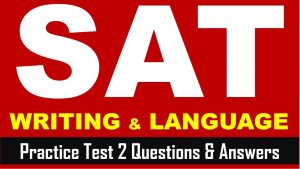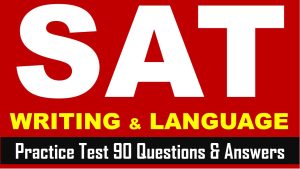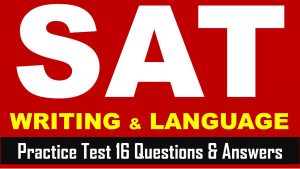Hi SAT Aspirants, welcome to AKVTutorials. As you know SAT (Scholastic Assessment Test) is a standard test, used for taking admission to undergraduate programs of universities or colleges of United States. SAT is developed and published by the College Board, an organization in United States, administered by the Educational Testing Service. Therefore, you need to do practice on SAT Reading Section, SAT Writing and Language Section. In this article, you will get SAT Writing Section Practice Test 52 with Answer Keys AMBIPi
Instruction:
- In the passage below is accompanied by a number of questions.
- For some questions, you need to think how the passage might be revised to improve the expression of ideas.
- For other questions, you will consider how the passage might be edited to correct errors in sentence structure, usage, or punctuation.
- Some questions will direct you to an underlined portion of a passage.
- Other questions will direct you to a location in a passage or ask you to think about the passage as a whole.
SAT Writing & Language Section Passage
SAT Writing Section Practice Test Passage Title: Thomas Jefferson, Academic Visionary
When authoring his epitaph, Thomas Jefferson omitted his two terms as the nation’s third president yet included “Father of the University of Virginia.” The Founding Father spent the last years of his life not in government but instead pursuing one of his most treasured 1 missions, it was creating the University of Virginia. As mastermind of the university’s architecture and curriculum, Jefferson assured that his legacy was sound.
Jefferson personally designed and oversaw the 2 Jefferson personally designed and oversaw the an “academical village.” At the front and center of a tree-lined lawn area, Jefferson strategically positioned the Rotunda, a round brick building featuring classical Greek columns in front. The domed top of the rotunda contained a library stocked with 7,000 books selected by Jefferson himself, while the area beneath included two floors of oval classrooms. 3 At that time, such prominent placement of the Rotunda was a marked departure from other universities’ designs, which generally featured chapels for the training of clergy.
Maximizing use of the grassy area in front of the Rotunda, Jefferson added ten two-story Romanesque pavilions for faculty housing and connected them to student dormitories with colonnades, column-lined covered walkways. To 4 sustain faculty through scholarly debates, Jefferson included dining halls in his design, referring to them as hotels.
5 In the spirit of his new nation, ending what he termed an “artificial aristocracy,” Jefferson introduced the notion of what we now call electives. In lieu of a strictly dictated curriculum, students could select from ten academic disciplines. 6 These disciplines were subject areas that ranged from ancient and modern languages to certain branches of science. (Not one to overlook the slightest detail, Jefferson showcased the ten categories by placing a carefully chosen Roman symbol on each of the ten pavilions.)
To support the science components of the university’s curriculum, Jefferson 7 has included a botanical garden, an experimental farm, and an observatory
8 Whereas Jefferson was highly involved in designing the architecture of the university. Jefferson ensured that the university, which would later be named a World Heritage site, encouraged free choice in classes, respect for classical roots, and 9 he was curious about the sciences.
Those 10 principles are forever remembered in the last portion of his 11 epitaph. The epitaph could easily have read “academic visionary for all Americans.”
SAT Writing Section Practice Test Questions
Question No 1
Which choice best maintains the sentence pattern already established in the paragraph?
Option A : No Change
Option B : missions. The creation of
Option C : missions, he created
Option D : missions: the creation of
Answer
Show/Hide Answer
Option D : missions: the creation of
Question No 2
Which of the following options is the most effective?
Option A : No Change
Option B : construction of what he would deem
Option C : construction of what he would deem,
Option D : construction, of what he would deem
Answer
Show/Hide Answer
Option B : construction of what he would deem
Question No 3
Which choice provides the most effectively transition to the information that follows?
Option A : No Change
Option B : Moreover,
Option C : For instance,
Option D : In contrast,
Answer
Show/Hide Answer
Option A : No Change
Question No 4
Which choice results in the most effective transition to the information that follows in the paragraph?
Option A : No Change
Option B : keep them fueled up while they were talking heatedly
Option C : fill them up so they could chat a bit about scholarly issues
Option D : make sure they could keep up school discussions
Answer
Show/Hide Answer
Option A : No Change
Question No 5
Which sentence most effectively establishes the main topic of the paragraph?
Option A : Some historians consider Jefferson a better architect than American statesman.
Option B : In order to further his legacy, Jefferson created an epitaph that many would discuss.
Option C : As meticulously as he laid out the grounds, Jefferson drafted an inspirational curriculum.
Option D : Thomas Jefferson’s legacy would not be intact if not for the university library
Answer
Show/Hide Answer
Option C : As meticulously as he laid out the grounds, Jefferson drafted an inspirational curriculum.
Question No 6
The writer is considering deleting the underlined sentence. Should the writer make this deletion?
Option A : Yes, because the information conveyed in this sentence is redundant with information provided elsewhere in the passage.
Option B : Yes, because the information conveyed in this sentence is inconsistent with information provided elsewhere in the passage.
Option C : No, because the information conveyed in this sentence provides useful information about the breakdown of disciplines that is further developed later in the paragraph.
Option D : No, because the information conveyed in this sentence explains why Jefferson relied heavily on classical Greek architecture.
Answer
Show/Hide Answer
Option C : No, because the information conveyed in this sentence provides useful information about the breakdown of disciplines that is further developed later in the paragraph.
Question No 7
Which choice best maintains the sentence pattern already established in the paragraph?
Option A : No Change
Option B : was including
Option C : could include
Option D : included
Answer
Show/Hide Answer
Option D : included
Question No 8
Which choice provides the smoothest and most logical transition to the new paragraph?
Option A : NO CHANGE
Option B : Although he didn’t live to see the full completion of the university’s construction, or even the graduation of the first senior class,
Option C : Due to his passion for classical architecture as well as his academic interest in astronomy, botany, and linguistics,
Option D : Because of Jefferson’s career in politics, which allowed him to mingle with some of the brightest thinkers of his day,
Answer
Show/Hide Answer
Option B : Although he didn’t live to see the full completion of the university’s construction, or even the graduation of the first senior class,
Question No 9
Which choice best maintains the sentence pattern already established in the paragraph?
Option A : No Change
Option B : in addition being curious
Option C : showed curiosity
Option D : curiosity
Answer
Show/Hide Answer
Option D : curiosity
Question No 10
Which choice best maintains the sentence pattern already established in the paragraph?
Option A : No Change
Option B : principals
Option C : principal’s
Option D : principles’
Answer
Show/Hide Answer
Option A : No Change
Question No 11
Which choice most effectively combines the sentences at the underlined portion?
Option A : epitaph; the last portion of it
Option B : epitaph, which, if stated differently,
Option C : epitaph, which
Option D : epitaph, and that
Answer
Show/Hide Answer
Option C : epitaph, which



